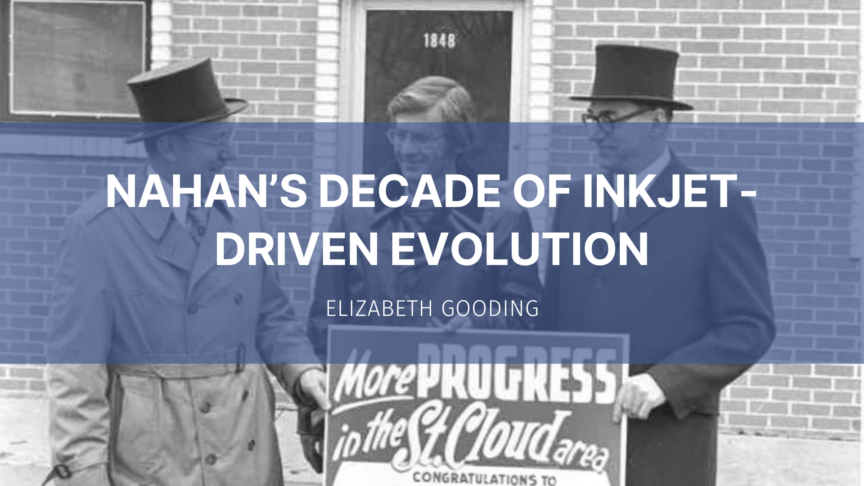It’s always fascinating to see the different trajectories that printing companies have taken over the years. Recently, Lois Ritarossi spoke to Maracle about their digital press evaluation that turned into doubling down on offset (for the time being.) On the other end of the spectrum, we see Nahan who were relatively early adopters of inkjet and have transformed portions of their business to run 100 percent digital, while consciously maintaining offset capabilities for specific segments.

Nahan began as a one-man print shop founded by Jim Nahan. Over the past 61 years, the company has amassed a staff of over 400 people in 2 locations. Camille Lehmann Rosa, Senior Marketing Specialist describes the company as a full-service direct marketing solution provider that puts the right people front and center. She says, “We’re strategists, designers, data analysts, production artists, quality-control fanatics, and logistics experts. We’re thinkers and doers. We’re investors in people, consultants to clients, and believers in collaboration. “

Camille Lehman Rosa
The company is about more than print, but print plays a central role in their success. Ten years ago, the company was a much more traditional printer known for high quality lithography. At that time, in their direct mail division, Nahan was producing personalized and versioned mail using a two-step process that employed offset for shells and monochrome toner presses for variable content. Technology included 2 Drent Vision UV web presses along with 3 Muller Martini Concept web presses and a fleet of 10 Océ continuous laser printers.
Scott Rau, Nahan Facility Engineer, recalls the discussions surrounding the evaluation and business case for inkjet, “As the volumes of personalized print continued to grow, it became easy to justify investment in inkjet. Instead of a two-step process, inkjet allowed us to complete the whole process, including personalization, in one step.”

Scott Rau
A Ten-Year Inkjet Journey
“Back in 2013 we were running everything on 1,000 feet per minute (fpm) cold offset forms presses,” says Rau. “We wanted to deliver quality as close to lithography as possible, but speed was the most critical factor. When the market got to a speed level of over 700 fpm and the print quality was acceptable for a wide variety of direct mail packages, it was go for inkjet.”
Nahan’s first press was a Screen TruePress 520ZZ installed in 2014, which remains in production today. In fact, Rau notes that they are closing in on 500 million pages produced on the press. Initially, inkjet only targeted a few, specific, high-volume jobs. Rau indicated that new business didn’t take hold early on because the salespeople were not fully on board with inkjet.
“I recall that convincing our Sales team was one of the hardest aspects of bringing inkjet into the mix,” Rau said. “Convincing them that the color quality was going to be on par with conventional was the challenge.” Lehmann Rosa adds, “Once the team understood the potential of inkjet, its power in personalization, speed-to market, and its effect on optimizing workflow by condensing steps, the sales team got excited.” In fact, after a few initial successes, sales quickly accelerated leading to the Concept presses and all of the toner presses being sold or retired within 2 years of investing in the Screen.
With the sales force fully on board, growth continued, and Nahan was able to justify investment in a second Screen Truepress 520zz Advanced with upgraded drying and chill rollers. “We then started shopping the Drent Vision UV presses out and were able to sell those in South Africa making us a 100% inkjet shop as of 2018,” says Rau.
However, all of the volume on the Screen presses was run on uncoated offset or inkjet treated stocks. As business continued to grow and the breadth of direct marketing services expanded, as well as the cost of inkjet formulated stocks, Nahan needed to find a solution that would handle offset coated stocks and meet an even higher benchmark for color and image quality. While very satisfied with the Screen relationship, they wanted to do a full competitive analysis to take their inkjet capabilities to the next level.
Tackling Coated Stocks
Nahan took their time and evaluated a range of options. The team performed more extensive due diligence on presses from 4 different OEMs. They did not just send samples and eyeball the result; they performed color and density measurements on the results as well as rub tests for ink fastness and durability. Rau noted that, at that time, for one press they tested, “The squalene in your skin would take the ink right off the piece. We found the Canon to be head and shoulders above the others in terms of rub tests.” (Rau notes that he has made site visits to other companies and visited trade events since that time where he noted that the fastness of the inks on machines they had evaluated earlier had improved significantly.) Nahan ultimately purchased a Canon ProStream 1800 as their 3rd inkjet press in 2021. They now run all of their coated work on the ProStream and their more extensive volume of uncoated work on the Screen TruePress devices.
A Lesson in Change Management
After 4 years, both toner and offset presses have been completely eliminated from Nahan’s most high growth division serving insert package direct mail. Lehmann Rosa advises, “While change can be exciting, it also can be an obstacle. For over 50 years, Nahan had been a conventional printer, known for its amazing quality. So naturally, change was scary. But there was a remedy – education.”
According to Rau, “We met the change management challenge by drawing on the expertise we had for optimizing color for our conventional presses and taking that to Inkjet and making it next level. We did a lot of print tests to prove the quality to our Sales team members so they could bring them to clients.” At the end of the day, the proof is always in the print. The company continues to use offset for approximately 50% of their production volume. Nahan uses 4, 5 and 6 color offset presses, along with inkjet one-to-one message options to serve the needs of their catalog customers. Whether produced using digital or traditional methods, Nahan continues to be known as a premium quality printer.

